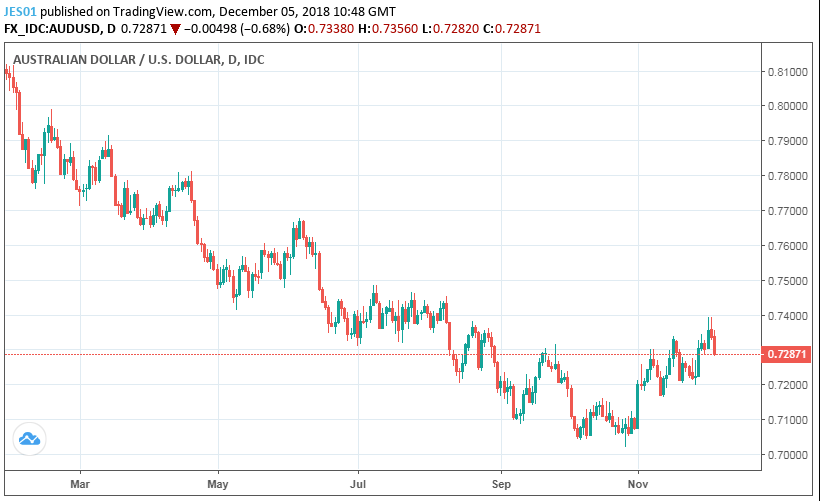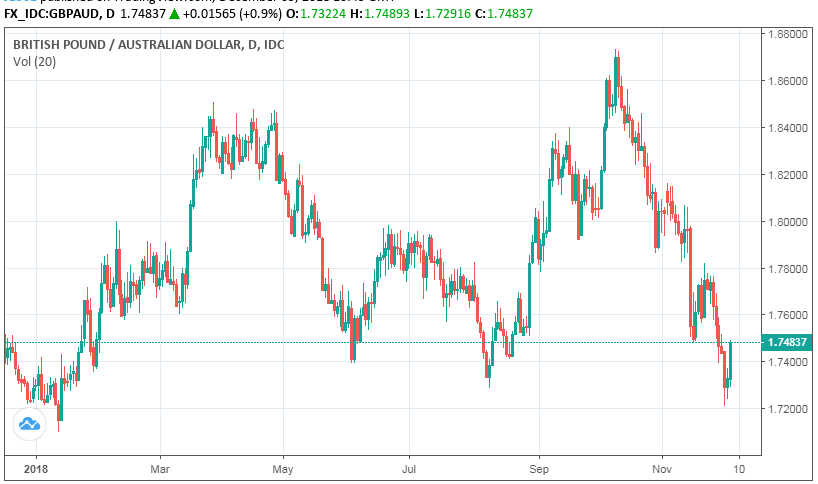Australian Dollar Slumps as Market Contemplates Odds of an RBA Rate Cut following GDP Disappointment
- Written by: James Skinner

© Taras Vyshnya, Adobe Stock
- AUD slides as growth data sees market eye RBA rate cut.
- GDP misses RBA forecasts, raises questions over outlook.
- After all sectors of economy underperform in third quarter.
The Australian Dollar retreated from multi-month highs Wednesday as traders began betting a Reserve Bank of Australia (RBA) interest rate cut could now be on the way following disappointing third-quarter growth data.
Australian GDP growth came in at just 0.3% for the third-quarter, according to the Australian Bureu of Statistics, down from 0.9% in the previous period and when consensus had looked for a 0.6% increase.
That took the annualised pace of expansion down from 3.1% previously, to 2.8% in the recent quarter when markets had looked for the economy to grow 3.3% relative to the same period one year ago.
Curiously, there was no one single cause of the slowdown. Instead, growth across almost all segments of the economy came in lower than earlier data had led economists to believe was likely.
A case in point is international trade. Tuesday's current account data and earlier trade balance figures had led many to suggest that 'net trade' would add 0.4% to GDP for the third quarter, but the ABS says it contributed only 0.3% to growth.
"While public spending and net exports were strong contributors to growth, housing construction only eked out a small gain and consumption growth slowed significantly. Business investment fell. Underlining the softness in consumption was further weakness in wages growth," says Felicity Emmett, an economist at Australia & New Zealand Banking Group.

Above: AUD/USD rate shown at daily intervals.
The AUD/USD rate was quoted 0.72% lower at 0.7291 Wednesday after retreating rapidly from a four-month high of 0.7390 in the previous session. It is now down by -6.6% for 2018.
The Pound-to-Australian-Dollar rate was up 0.86% at 1.7471 and has now gained 1.4% for 2018 after rising off a four-month low in the previous session.
But High Street lenders are offering only between 1.6730 and 1.6852 for international payments and transfers at the same time.
Specialist providers are offering better rates than that, with quotes spanning the 1.7180 to 1.7216 bracket.

Above: Pound-to-Australian-Dollar rate shown at daily intervals.
Wednesday's numbers reveal a cocktail of developments took place in the recent quarter that are likely to leave policymakers at the Reserve Bank of Australia feeling uneasy.
The RBA upgraded its forecasts last month when it said growth would average 3.5% in 2018 and 2019 rather than the 3% it previously projected. That move now appears to have been a fool hardy one.
But not only that, the bank has repeatedly warned that the ongoing downturn in the housing market poses a threat to household confidence and the economy.
It's also long-lamented weak wage growth that has made attainment of the inflation target all the more difficult, with that weakness explaining 2018's deteriorating interest rate outlook and losses for the currency.
"Despite softer than expected, Q3 growth was around potential and should keep unemployment low. But it points to limited pressure on prices and wages. The RBA may be a little concerned that their current growth forecasts are off track so soon after finalising them," says Philip Brown, a bond market strategist at Commonwealth Bank of Australia.
Advertisement
Bank-beating exchange rates. Get up to 5% more foreign exchange by using a specialist provider to get closer to the real market rate and avoid the gaping spreads charged by your bank when providing currency. Learn more here
Market Eyes RBA Rate Cuts as 'Tariff Man' Returns
The Aussie's losses Wednesday are the result of the dire GDP data hitting market confidence in the Reserve Bank's ability to lift its interest rate from the current record low of 1.5% over the next year.
Currency markets care about the GDP data because it reflects rising and falling demand that has a direct bearing on inflation.
Changes in rates are only normally made in response to movements in inflation but impact currencies because of the influence they have over capital flows and their allure for short-term speculators.
Pricing in interest rate derivative markets, which provides insight into expectations for monetary policy, has shifted and now shows investors flirting with the idea of a rate cut over coming months.
The market-implied Australian cash rate is below the current 1.5% for the first Tuesday of each month until October 2019, suggesting the market views a rate cut as more likely than a hike at each of those meetings.
This comes immediately after President Donald Trump used his Twitter account to remind the world that tariffs on Chinese exports to the U.S. will rise in 90 days if a satisfactory resolution to differences over trade is not found by negotiators.
....I am a Tariff Man. When people or countries come in to raid the great wealth of our Nation, I want them to pay for the privilege of doing so. It will always be the best way to max out our economic power. We are right now taking in $billions in Tariffs. MAKE AMERICA RICH AGAIN
— Donald J. Trump (@realDonaldTrump) December 4, 2018
"We are either going to have a REAL DEAL with China, or no deal at all - at which point we will be charging major tariffs against Chinese product being shipped into the United States. Ultimately, I believe, we will be making a deal - either now or into the future...China does not want tariffs," Trump later wrote on Twitter.
Those comments disrupted a fragile peace in financial markets and also weighed on the Australian Dollar overnight given the Antipodean currency's recent strength was derived from the U.S.-China agreement struck at the weekend's G20 summit.
The deal had averted a January 01 increase in tariffs that many said would damage the global economy and gave rise to a continued relief rally by the China-exposed Aussie Dollar, although many were immediately sceptical of how long it would last.
"We expect the Aussie to continue to be mainly driven by external developments in the coming months," says lee Hardman, a currency analyst at MUFG, in a note Tuesday. "The worst case outcome for the Aussie would be break down in US and China trade talks which leads to the imposition of further tariffs and exacerbates the slowdown in global growth."
Advertisement
Bank-beating exchange rates. Get up to 5% more foreign exchange by using a specialist provider to get closer to the real market rate and avoid the gaping spreads charged by your bank when providing currency. Learn more here




